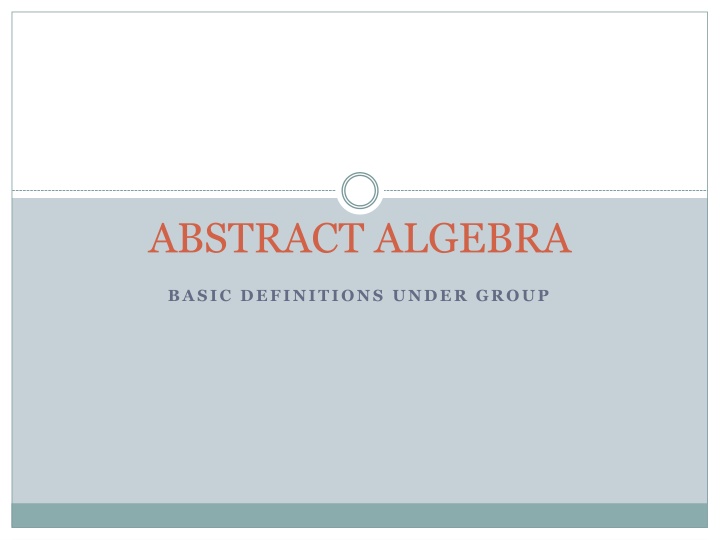
Abstract Algebra Basic Definitions and Group Properties
Explore the fundamental concepts of abstract algebra, including group theory definitions, properties such as closure, associativity, identity, and inverses. Learn about subgroups, isomorphic groups, order of an element, permutation groups, and normal subgroups in this comprehensive overview of abstract algebra.
Download Presentation

Please find below an Image/Link to download the presentation.
The content on the website is provided AS IS for your information and personal use only. It may not be sold, licensed, or shared on other websites without obtaining consent from the author. If you encounter any issues during the download, it is possible that the publisher has removed the file from their server.
You are allowed to download the files provided on this website for personal or commercial use, subject to the condition that they are used lawfully. All files are the property of their respective owners.
The content on the website is provided AS IS for your information and personal use only. It may not be sold, licensed, or shared on other websites without obtaining consent from the author.
E N D
Presentation Transcript
ABSTRACT ALGEBRA BASIC DEFINITIONS UNDER GROUP
GROUP A group is a nonempty set tt on which there is defined a binary operation (a, b) following properties. Closure: If a and b belong to tt, then ab is also in tt; Associativity : a(bc) = (ab)c for all a, b, c tt; Identity : There is an element 1 tt such that a1 = 1a = a for all a in tt; Inverse: If a is in tt, then there is an element a 1in tt such that aa 1= a 1a = 1. ab satisfying the
ABELIAN GROUP A group tt is abelian if the binary operation is commutative, i.e., ab = ba for all a, b in tt. In this case the binary operation is often written additively ((a, b) a + b), with the identity written as 0 rather than 1.
SUBGROUP A subgroup H of a group tt is a nonempty subset of tt that forms a group under the binary operation of tt. Equivalently, H is a nonempty subset of tt such that if a and b belong to H, so does ab 1.
ISOMORPHIC The groups tt1and tt2are said to be isomorphic if there is a bijection f : tt1tt2that preserves the group operation, in other words, f (ab) = f (a)f (b). Isomorphic groups are essentially the same; they differ only notationally.
ORDER OF AN ELEMENT If tt is a finite cyclic group of order n, then tt has exactly one (necessarily cyclic) subgroup of order n/d for each positive divisor d of n, and tt has no other subgroups.
PERMUTATION GROUPS A permutation of a set S is a bijection on S, that is, a function : S S that is one- to-one and onto. (If S is finite, then is one-to-one if and only if it is onto.) If S is not too large, it is feasible to describe a permutation by listing the elements x S and the corresponding values (x).
NORMAL SUGROUPS Let H be a subgroup of tt. If any of the following equivalent conditions holds, we say that H is a normal subgroup of tt, or that H is normal in tt: cHc 1 H for all c tt (equivalently, c 1Hc H for all c tt). cHc 1= H for all c tt (equivalently, c 1Hc = H for all c tt). cH = Hc for all c tt. Every left coset of H in tt is also a right coset. Every right coset of H in tt is also a left coset.
QUOTIENT GROUPS If H is normal in tt, we may define a group multiplication on cosets, as follows. If aH and bH are (left) cosets, let (aH)(bH) = abH; by (1.3.7), (aH)(bH) is simply the set product. If a1is another member of aH and b1 another member of bH, then a1H = aH and b1H = bH (Problem 5). Therefore the set product of a1H and b1H is also abH. The point is that the product of two cosets does not depend on which representatives we select. To verify that cosets form a group under the above multiplication, we consider the four defining requirements. Closure: The product of two cosets is a coset. Associativity : This follows because multiplication in tt is associative. Identity : The coset 1H = H serves as the identity. Inverse: The inverse of aH is a 1H.
HOMEOMORPHISM If f : tt H, where tt and H are groups, then f is said to be a homomorphism if for all a, b in tt, we have f (ab) = f (a)f (b).




